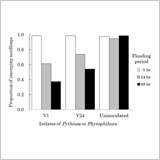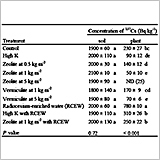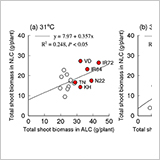Crop Physiology
The Long-Term Changes in Midday Photoinhibition in Rice (Oryza sativa L.) Growing under Fluctuating Soil Water Conditions
K. Iseki, K. Homma, T. Irie, T. Endo and T. Shiraiwa
- Long-term changes in midday photoinhibition in a rainfed rice field were evaluated by determining the maximum quantum yield of photosystem II (Fv/Fm).
- Fv/Fm was generally lower under rainfed conditions than under flooded conditions at 65–75 days after sowing (DAS), but was similar under both conditions at 109–124 DAS.
- Genotypic differences in the long-term changes in Fv/Fm might be determined by the capacity of the cultivar to adapt to drought conditions.
Abstract Full Text PDF[685K] |
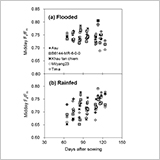 |
Genetic Resources Evaluation
Genotypic Diversity of Cross-Tolerance to Oxidative and Drought Stresses in Rice Seedlings Evaluated by the Maximum Quantum Yield of Photosystem II and Membrane Stability
K. Iseki, K. Homma, T. Endo and T. Shiraiwa
- The maximum quantum yield of photosystem II (Fv/Fm) and the membrane stability index (MSI) were measured to assess the oxidative damage induced by methyl viologen (MV) for oxidative stress and polyethylene glycol (PEG) for drought stress in 67 rice cultivars.
- Considerable variations in Fv/Fm and MSI among the cultivars in MV treatment indicated the existence of genotypic diversity in the susceptibility to oxidative damage.
- Cross-tolerance to oxidative damage under MV and PEG treatments was higher in cultivars in the japonica group than in the indica groups and higher in the improved cultivars than in the landraces.
Abstract Full Text PDF[694K] |
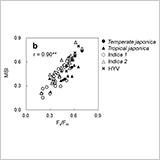 |
Allelopathic Potential of White, Red and Black Rice Cultivars
H. Kato-Noguchi, K. Nitta and T. Itani
- The inhibitory effect (allelopathic potential) of shoot, seed and root extracts of 8 white, 5 red and 5 black rice (Oryza sativa L.) cultivars was determined against the seedling growth of lettuce (Lactuca sativa L.) and white clover (Trifolium repens L.).
- All extracts inhibited hypocotyl and root growth of lettuce and white clover seedlings, and those inhibitory activities ranged from -1%-96%.
- The red rice cultivar Tsushima-akamai marked the greatest inhibitory activity with an average of 88 % growth inhibition on hypocotyls and roots of lettuce and white clover, followed by Souja-akamai, suggesting that the two cultivars may be potentially useful for weed management in agriculture.
Abstract Full Text PDF[613K] |
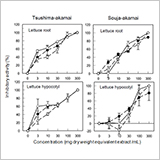 |
Agronomy & Crop Ecology
Enhanced Nitrogen Uptake and Photosynthesis of Rice Grown with Deep and Permanent Irrigation Method: Possible Mechanism for Chalky Grain Reduction
M. Hayashi, T. Hayashi, C. Kuno, T. Tani, I. Endo, A. Higashino, M. Nakata-Kano and A. Yamauchi
- Previously we have demonstrated that the deep and permanent irrigation method, which is the combination of the V-furrow direct seeding and deep-flood irrigation methods, reduced chalky grain occurrence.
- In this study, leaf N content, stomatal conductance and photosynthetic rate were significantly higher in the deep-flood treatment that maintained a 20 cm water depth than the control with only a 10 cm water depth.
- The deep-flood treatment reduced chalky grain formation, probably because of the improvement in source activity.
Abstract Full Text PDF[643K] |
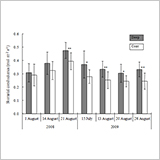 |
Agronomic Traits for High Productivity of Aerobic Rice Culture in Progeny of a Japonica Cultivar and a High-Yielding Indica Cultivar
K. Katsura
- Most of the CSSLs had a higher grain yield than Sasanishiki in aerobic culture, whereas their average was close to that of Sasanishiki in flooded culture.
- Rice plants grown in aerobic culture had larger biomass production, which enabled most of the CSSLs to produce more spikelets per unit area and maintain single-grain weight, thereby producing a higher grain yield than Sasanishiki.
- These results suggest that high spikelet producing ability would promote high grain yield in aerobic culture.
Abstract Full Text PDF[742K] |
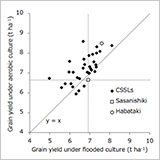 |
Yields from Rice Plants Cultivated under Tree Canopies in Rainfed Paddy Fields on the Central Plain of Laos
S. Miyagawa, M. Seko, M. Harada and S. Sivilay
- Grain yield of rice plants cultivated in close proximity to tree trunks (CTP) was higher than that of the plants cultivated far away from the tree trunks (FTP) in 5 fields but lower in 7 fields out of 75 fields in the total for 3 years.
- No relationship was observed between the changes in photosynthetic photon flux density due to interception by the tree and the ratio of grain yield of CTP to that of FTP.
- Tree utilization combined with rice cultivation is currently compatible in the investigated village.
Abstract Full Text PDF[640K] |
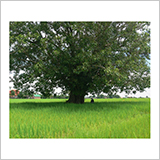 |
Varietal Differences in Cell Wall β-(1→3),(1→4)-Glucan and Nonstructural Carbohydrates in Rice Stems during the Grain Filling Stage
Y. Arai-Sanoh, M. Ida, R. Zhao, K.o Nishitani, S. Yoshinaga, T. Takai, H. Nakano, N. Iwasawa and M. Kondo
- The contributions of β-(1→3),(1→4)-glucan and nonstructural carbohydrate (NSC) in stems to grain filling were investigated among rice varieties.
- When the top half of panicle was removed, the decrease in β-(1→3),(1→4)-glucan and NSC in stems were much smaller than the intact plant.
- The results suggest that β-(1→3),(1→4)-glucan is one of the sources that supply substrate to panicle as well as NSC.
Abstract Full Text PDF[741K] |
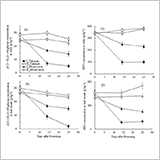 |
Hagberg Falling Number and Rheological Properties of Wheat Cultivars in Wet and Dry Preharvest Periods
S. Dencic, R. DePauw, B. Kobiljski and V. Momcilovic
- Differential expression of resistance to sprouting can be detected under wet preharvest conditions.
- The cultivars were divided into 3 groups according to Hagberg Falling Number (HFN) value.
- The cultivars in high HFN group (>400s) were superior in almost all rheological properties.
Abstract Full Text PDF[911K] |
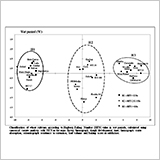 |
Assimilating Remotely Sensed Information with the WheatGrow Model Based on the Ensemble Square Root Filter for Improving Regional Wheat Yield Forecasts
Y. Huang, Y. Zhu, W. Li, W. Cao and Y. Tian
- Remote sensing (RS) coupled with WheatGrow model improved crop yield predictions.
- Ensemble Square Root Filter algorithm increased model assimilation efficiency.
- The optimized RS-WheatGrow model reliably predicted crop yield at the regional scale.
Abstract Full Text PDF[1803K] |
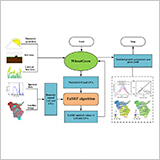 |
Long-term effect of Year-Round Tillage Patterns on Yield and Grain Quality of Wheat
Y. Tang, X. Wu, C. Li, C. Wu, X. Ma and G. Huang
- A 7-year field experiment under a rice-wheat rotation system was conducted at Guanghan County in the Chengdu Plain of China to investigate the long-term effect of different combinations of year-round tillage patterns and crop straw management on grain yield and quality of wheat.
- There was little variation amongst years in grain yield and yield components with the treatment, while conventional treatment had lower yields in most years than other treatments with a slight decreasing trend.
- Zero tillage and straw mulching improved wheat tiller ability, soil available nitrogen, phosphorus, and potassium contents at major growth stages, and leaf area index, SPAD, and dry matter at middle and late stages.
- Most grain quality traits of wheat were nearly the same in all treatments in all year-round tillage patterns.
Abstract Full Text PDF[758K] |
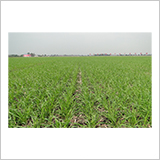 |
Root Growth of Two Soybean [Glycine max (L.) Merr.] Cultivars Grown under Different Groundwater Level Conditions
N. Matsuo, M. Takahashi, K. Fukami, S. Tsuchiya and K. Tasaka
- Root growth response of two soybean cultivars (Fukuyutaka and Sachiyutaka) to groundwater level was examined.
- Root growth of two cultivars ceased just below groundwater level and Root growth of Fukuyutaka was greater than that of Sachiyutaka at the early growth stage.
- These results suggested that optimum groundwater level differed between two cultivars, leading to develop the groundwater level control technique by subirrigation-drainage system, FOEAS.
Abstract Full Text PDF[566K] |
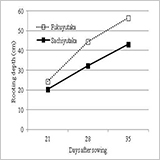 |
Evaluation of Mixed Cropping of Oat and Hairy Vetch as Green Manure for Succeeding Corn Production
A. Tarui, A. Matsumura, S. Asakura, K. Yamawaki, R. Hattori and H. Daimon
- Dry matter production of green manure was the highest in mixed cropping.
- N and P contents of oat were greatly increased by cutting mixed-cropped hairy vetch.
- Mixed cropping green manure enhanced the growth and nutrient uptake of the succeeding corn crop.
Abstract Full Text PDF[2947K] |
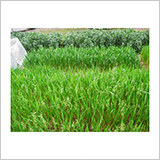 |













